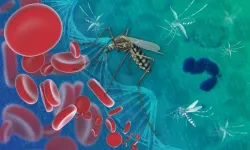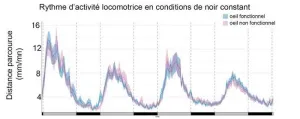(Press-News.org) By dissecting the genetic diversity of the most deadly human malaria parasite – Plasmodium falciparum – researchers at EMBL’s European Bioinformatics Institute (EMBL-EBI) have identified a mechanism of ‘copy-paste’ genetics that increases the genetic diversity of the parasite at accelerated time scales. This helps solve a long-standing mystery regarding why the parasite displays hotspots of genetic diversity in an otherwise unremarkable genetic landscape.
Malaria is most commonly transmitted through the bites of female Anopheles mosquitoes infected with P. falciparum. The latest world malaria report states that in 2022, there were an estimated 249 million malaria cases and over 600,000 malaria deaths across the globe. 94% of malaria cases and 95% of malaria deaths are found in Africa, with infants, pregnant women, travellers, and people with HIV/AIDS being at higher risk.
The new study, published in the journal PLOS Biology, provides key insights into the evolutionary history of P. falciparum through the analysis of two genes that encode surface proteins critical to immune evasion. The genes in question are DBLMSP and DBLMSP2.
These findings deepen our understanding of how the malaria parasite has evolved and could help to inform new approaches to vaccine development, offering hope for more effective prevention methods against a disease that continues to impact millions globally.
Copy-paste genetics
Usually, the sequence of an individual’s gene is inherited from their parents, but in some circumstances, part of a gene sequence can be copied between different genes on the same DNA molecule – this is known as non-allelic gene conversion. This process has been linked to the evolution of important gene families, including those involved in the functioning of the human immune system.
One of this study's key discoveries is that gene conversion takes place between the P. falciparum DBLMSP and DBLMSP2 genes and results in increased genetic diversity within the surface proteins of the parasite. Since these proteins are exposed to, and interact with our immune system, they are potential vaccine targets, and a fuller understanding of their genetic diversity could be very valuable for vaccine design.
"The discovery of 'copy-paste' genetics within malaria's DNA reveals the impact of an underestimated evolutionary mechanism," said Brice Letcher, Postdoctoral Researcher at the Laboratory for Biology and Modelling of the Cell (LBMC, France) and former PhD student at EMBL-EBI. "Here we show that gene conversion was a potentially important strategy behind malaria’s ability to adapt and thrive in humans, including possibly to evade the human immune system. Understanding this genetic flexibility offers new perspectives on malaria's persistence in and adaptation to the human host."
Mapping hidden genetic diversity in malaria parasites
Any immune-interacting protein is potentially a vaccine target, but knowledge of global genetic diversity is an important requirement for vaccine development. For example, influenza and SARS-CoV-2 vaccines are developed based on the knowledge of how their genomes have evolved. However, the very unusual hotspots of genetic diversity in the P. falciparum DBLMSP and DBLMSP2 genes are so extreme that current algorithms for mapping genetic variants failed to capture them, leaving researchers unaware of a large proportion of the variation in these genes.
To address this, the researchers developed new bioinformatics software that uses genome graphs and analysed a broad sample of parasites from 29 countries. This new approach revealed a wide range of previously hidden variants, and with these, they were able to demonstrate that multiple gene conversion events had occurred. These new variants, available for download from the website linked to the study, provide a valuable resource for the malaria research community.
"Genome graphs are a great bioinformatics method to help us decode the complex genetic landscapes arising from the interplay between pathogens and human hosts," said Sorina Maciuca, co-author and former PhD student in the Iqbal group and Genomics Data Scientist at Genomics England. "They allow us to take into account a broader spectrum of genetic diversity and obtain new insights into how pathogens like P. falciparum evolve and evade our immune defences."
What are genome graphs?
The traditional approach in genomics is to define one reference genome and describe any other genome as a set of small differences from this reference. This does not work well when genomes differ too much. Genome graphs take a population of genomes and build an ensemble reference which is aware of all of the genetic variation in the species.
"This research provides a comprehensive map of genetic diversity of these two fascinating genes in P. falciparum," said Zamin Iqbal, Group Leader at EMBL-EBI and Professor of Algorithmic and Microbial Genomics at the University of Bath. "We have been trying to understand the unusual patterns in these genes for almost a decade now, and our best hypothesis had been that the really different “versions’’ of the gene were being preserved by natural selection, for unknown reasons. We have shown here that, in fact, this copying mechanism – gene conversion – has been repeatedly creating these anomalous different “versions” of the genes. This data not only enhances our grasp of malaria's biology, but also will be valuable to researchers across the world studying these genes and their interaction with our immune system."
END
The Malaria parasite generates genetic diversity using an evolutionary ‘copy-paste’ tactic
Plasmodium falciparum, a malaria parasite, uses gene conversion to produce genetic diversity in two surface protein genes targeted by the human immune system
2024-03-07
ELSE PRESS RELEASES FROM THIS DATE:
Loss of nature costs more than previously estimated
2024-03-07
Researchers propose that governments apply a new method for calculating the benefits that arise from conserving biodiversity and nature for future generations.
The method can be used by governments in cost-benefit analyses for public infrastructure projects, in which the loss of animal and plant species and ‘ecosystem services’ – such as filtering air or water, pollinating crops or the recreational value of a space – are converted into a current monetary value.
This process is designed to make biodiversity loss and the benefits of nature conservation more visible in political decision-making.
However, the international research team ...
Lack of functional eyes does not affect biological clock in zebrafish
2024-03-07
Functional eyes are not required for a working circadian clock in zebrafish, as a research team1 including CNRS scientists has now shown.
Though it is understood that the eye plays a key role in mammalian adaptation to day-night cycles, the circadian clock is most often studied in nocturnal vertebrates such as mice. The zebrafish, in contrast, is a diurnal vertebrate. Through observation of various zebrafish larvae lacking functional eyes,2 the team of scientists has demonstrated that the latter are not needed to establish circadian rhythms that remain synchronized with light-dark ...
The who's who of bacteria: A reliable way to define species and strains
2024-03-07
What’s in a name? A lot, actually.
For the scientific community, names and labels help organize the world’s organisms so they can be identified, studied, and regulated. But for bacteria, there has never been a reliable method to cohesively organize them into species and strains. It’s a problem, because bacteria are one of the most prevalent life forms, making up roughly 75% of all living species on Earth.
An international research team sought to overcome this challenge, which has long plagued scientists who study bacteria. Kostas Konstantinidis, Richard ...
Forbes ranks the University of Colorado Denver | Anschutz Medical campus among America’s best employers
2024-03-07
The University of Colorado Denver | Anschutz Medical Campus is listed as one of Forbes America’s Best Large Employers for 2024.
The 2024 list of “America’s Best Employers” was conducted by Forbes and market research firm Statista, the world-leading statistics portal and industry ranking provider.
“This ranking is meaningful to our organization because the people who work at CU Anschutz drive our success as a leading academic medical campus by providing unparalleled patient care services, being a premier national leader in research and innovation, and fostering a supportive learning ...
NJIT professor trains college counselors to help fight antisemitism
2024-03-07
As data from the Anti-Defamation League shows antisemitism growing on college campuses in recent years and spiking after the Hamas-Israel conflict, a New Jersey Institute of Technology researcher is doing her part to combat the trend by developing a training model that will help prepare mental health professionals who work with Jewish students.
Modern students are hearing people chant slogans without understanding the intentions behind the words, or finding swastikas and other anti-Jewish graffiti on their campuses, but they are not encountering suitably trained counselors and psychologists who understand their ...
For new moms who rent, housing hardship and mental health are linked
2024-03-07
Becoming a parent comes with lots of bills. For new mothers, being able to afford the rent may help stave off postpartum depression.
“Housing unaffordability has serious implications for mental health,” said Katherine Marcal, an assistant professor at the Rutgers School of Social Work and author of a study published in the journal Psychiatry Research. “For mothers who rent their homes, the ability to make monthly payments appears to have a correlation to well-being.”
Housing hardship – missing rent or mortgage payments, moving in with others, being evicted ...
MD Anderson research highlights for March 7, 2024
2024-03-07
HOUSTON ― The University of Texas MD Anderson Cancer Center’s Research Highlights showcases the latest breakthroughs in cancer care, research and prevention. These advances are made possible through seamless collaboration between MD Anderson’s world-leading clinicians and scientists, bringing discoveries from the lab to the clinic and back.
Recent developments at MD Anderson offer clinical insights into a novel treatment strategy for patients with relapsed/refractory acute myeloid leukemia (AML), molecular insights into Burkitt lymphoma development, a therapeutic target to overcome ...
Prepare workers to weather time shocks
2024-03-07
AUSTIN, Texas — Managers can do much to help their workers become more resilient to inevitable time disruptions in today’s workplace, says new research from The University of Texas at Austin.
With intricate supply chains and operations that sprawl across time zones, workplace time disturbances are only increasing. Such temporal disruptions aren’t just inconvenient, says David Harrison, Texas McCombs professor of management professor: They can carry tangible business costs, such as impaired health, increased mistakes, and reduced ...
The health impacts of migrating by sea
2024-03-07
In the four years after the border wall height was increased from 17 feet to 30 feet along the US-Mexican border, drowning deaths of migrants in the Pacific Ocean off the coast of San Diego increased by 3200%, according to a new study published in JAMA. Co-authors Anna Lussier, M.D, Ph.D. student in the University of California San Diego School of Medicine, and Peter Lindholm, M.D., Ph.D., Gurnee Endowed Chair of Hyperbaric and Diving Medicine Research and professor in residence in the Department of Emergency Medicine at UC San Diego School of Medicine, ...
Democratic backslide a threat to free elections globally
2024-03-07
Over half of the 60 countries holding national elections this year are experiencing a democratic decline, risking the integrity of the electoral process, as reported in the latest Democracy Report from the V-Dem Institute at the University of Gothenburg. The worsening election quality is concerning, given the pivotal role elections play in either reinforcing or mitigating the trend of autocratization.
The wave of democratic backsliding, or autocratization, continues to be noticeable, according to the report. 42 countries are autocratizing, and 71 percent of the world’s population now live in autocracies – up from 48 percent ten years ago. There ...
LAST 30 PRESS RELEASES:
Manta rays create mobile ecosystems, study finds
Study: Mixed results in using lipoic acid to treat progressive multiple sclerosis
Norbert Holtkamp appointed director of Fermi National Accelerator Laboratory
New agentic AI platform accelerates advanced optics design
Biologists discover neurons use physical signals — not electricity — to stabilize communication
Researchers discover that a hormone can access the brain by hitchhiking
University of Oklahoma researcher awarded funding to pursue AI-powered material design
Exploring how the visual system recovers following injury
Support for parents with infants at pediatric check-ups leads to better reading and math skills in elementary school
Kids’ behavioral health is a growing share of family health costs
Day & night: Cancer disrupts the brain’s natural rhythm
COVID-19 vaccination significantly reduces risk to pregnant women and baby
The role of vaccination in maternal and perinatal outcomes associated with COVID-19 in pregnancy
Mayo Clinic smartwatch system helps parents shorten and defuse children's severe tantrums early
Behavioral health spending spikes to 40% of all children’s health expenditures, nearly doubling in a decade
Digital cognitive behavioral treatment for generalized anxiety disorder
Expenditures for pediatric behavioral health care over time and estimated family financial burden
Air conditioning in nursing homes and mortality during extreme heat
The Alps to lose a record number of glaciers in the next decade
What makes a good proton conductor?
New science reporting guide published for journalists in Bulgaria
New international study reveals major survival gaps among children with cancer
New science reporting guide published for journalists in Turkey
Scientists develop a smarter mRNA therapy that knows which cells to target
Neuroanatomy-informed brain–machine hybrid intelligence for robust acoustic target detection
Eight SwRI hydrogen projects funded by ENERGYWERX
The Lundquist Institute and its start-up company Vitalex Biosciences Announces Strategic Advancement of Second-Generation fungal Vaccine VXV-01 through Phase 1 Trials under $40 Million Competitive Con
Fine particles in pollution are associated with early signs of autoimmune disease
Review article | Towards a Global Ground-Based Earth Observatory (GGBEO): Leveraging existing systems and networks
Penn and UMich create world’s smallest programmable, autonomous robots
[Press-News.org] The Malaria parasite generates genetic diversity using an evolutionary ‘copy-paste’ tacticPlasmodium falciparum, a malaria parasite, uses gene conversion to produce genetic diversity in two surface protein genes targeted by the human immune system



